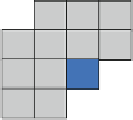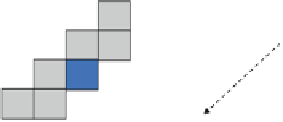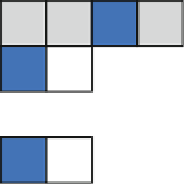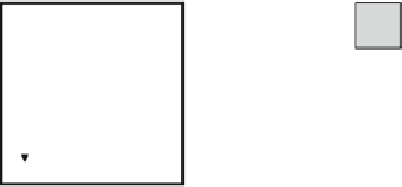Graphics Reference
In-Depth Information
Fig. 8.13
Local templates
for SIG context selection.
X(in
blue
) represents the
current position of the bin
being processed. (
a
)Ten
neighbors (HM1.0), (
b
) eight
neighbors, (
c
) six neighbors,
(
d
) 5 neighbors (HM3.0), and
(
e
) inverted for reverse scan
(HM4.0)
a
b
D
H
J
H
J
A
E
I
K
E
I
K
B
X
B
F
X
F
C
G
C
G
c
d
J
H
E I
B F
X
I
K
F
X
C
G
e
X
F
B
I
E
H
Fig. 8.14
Scans used to
process SIG. Diagonal scan
avoids dependency on the
most recently processed bin.
Context selection for
blue
positions is affected by values
of the neighboring
grey
positions. (
a
) Zig-zag scan
and (
b
) diagonal scan
a
b
showninFig.
8.13
d. In HM2.0, the significance map was scanned in zig-zag order,
so removing the diagonal neighbors G and K is important since those neighbors
pertain to the most recently decoded SIG.
Despite reducing the number of SIG neighbors in HM2.0, dependency on the
most recently processed SIG neighbors still existed for the positions at the edge of
the transform block as shown in Fig.
8.14
a. The horizontal or vertical shift that is
required to go from one diagonal to the next in the zig-zag scan causes the previously
decoded bin to be one of the neighbors (F or I) that is needed for context selection.
In order to address this issue, in HM4.0, a diagonal scan was introduced to replace
the zig-zag scan [
86
] as shown in Fig.
8.14
b. Changing from zig-zag to diagonal
scan had negligible impact on coding efficiency, but removed the dependency on
recently processed SIG for all positions in the TB. In HM4.0, the scan was also
reversed (from high frequency to low frequency) [
74
]. Accordingly, the neighbor
dependencies were inverted from top-left to bottom-right, as shown in Fig.
8.13
e.
Dependencies in context selection of SIG for 16
16 and 32
32 TBs
were further reduced in HM7.0, where 16
16 and 32
32 TBs are divided
into 4
4 subblocks. This will be described in more detail in Sect.
8.6.4.3
on












































